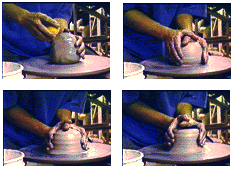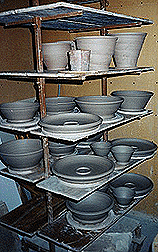Second, she has to get all of her other materials ready, as shown in this picture. Her clay is formed into a workable shape for the wheel. There is a bucket of water nearby to use while working on the wheel (so the clay doesn't dry out and is easier to work with), and all of her shaping tools are within reach. |

|
|
 |
Third, she starts to actually work with the clay on the pottery wheel. In the picture to the left, Laura is shown hitting the clay in order to make sure it is secure to the platform, centered, and prepared for the next stage. |
Fourth, Laura actually forms the pot. She dips her hands into her water bucket and starts to manipulate the clay, as shown in the pictures to the right. The process where she forms the pot on the wheel is called throwing. Laura keeps throwing the pot until she is satisfied with its shape and form. "...I throw things, and then sometimes I will alter them after they have been thrown." These alterations are usually minor, unless she decides to make complex cut-outs in the pot. |
 |
 |
Fifth, Laura allows the finished pot to dry completely. This picture shows a shelf in Laura's workshop where she places her pots after she is finished throwing them. The pots cannot be fired in the kiln until they are dried. Pots that are drying like these are called greenware. |
Sixth, Laura fires the the greenware in her kiln, which is shown at the right. Firing the pot in the kiln enables Laura to be able to glaze it once it is done. She does not fire her kiln once for every pot; instead, she carefully stacks many of her finished works inside the kiln in order to be fired. |

|